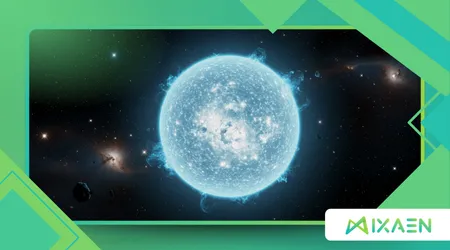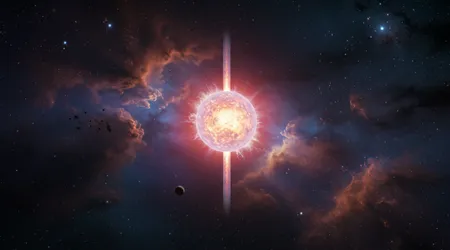Could There Be Stars Made of Antimatter?

Could There Be Stars Made of Antimatter? the universe, as far as our instruments can confirm, is overwhelmingly composed of ordinary matter.
Anúncios
This cosmic imbalance is one of physics’ greatest unsolved puzzles, the asymmetry known as baryogenesis. However, the fundamental laws of physics suggest a perfect symmetry: for every particle of matter, there should be an equivalent antiparticle.
This raises a thrilling, profound question: Could There Be Stars Made of Antimatter? These hypothetical objects, called anti-stars, would look identical to normal stars but carry an inverse atomic charge.
Searching for these anti-stars is not merely a theoretical exercise; it’s a direct quest to understand the distribution of matter and antimatter throughout the cosmos.
Detecting one would fundamentally rewrite our models of the Big Bang and cosmic evolution. We delve into the ongoing astrophysical search, the distinct annihilation signature we seek, and why current observations make this possibility remote yet utterly captivating.
Anúncios
The Asymmetry Problem: Where Did the Antimatter Go?
The mystery of anti-stars begins at the very start of time, during the universe’s rapid infancy. Understanding the matter-antimatter balance is key.
H3: Baryogenesis and the Missing Half
Current cosmological models predict that the Big Bang should have created equal amounts of matter and antimatter. If this perfect symmetry had held, the universe would now be a dense sea of pure energy, the result of mutual annihilation.
The fact that the universe exists at all populated by galaxies, planets, and us means a minuscule imbalance, perhaps one part in a billion, favored matter. This process, termed baryogenesis, is still poorly understood.
The question of Could There Be Stars Made of Antimatter thus boils down to whether that early asymmetry was localized or truly universal. If pockets of antimatter survived and clumped together, anti-stars are possible.
++ Are We Missing 95% of What the Universe Is Made Of?
The Local Bubble Confirmation
Decades of observations of the nearby cosmos offer compelling evidence that our solar system and the Milky Way are primarily matter-dominated. Interactions between cosmic rays and interstellar gas provide the proof.
When high-energy cosmic rays (matter particles) hit interstellar gas (also matter), they produce predictable radiation signatures. If a significant cloud of antimatter gas existed nearby, we would observe powerful annihilation gamma-rays constantly.
Since we don’t observe this overwhelming, localized annihilation, we conclude the observable universe nearby is overwhelmingly made of matter. This makes local anti-stars highly improbable.

The Signature Search: How to Spot an Anti-Star
Since an anti-star emits light and gravity identically to a normal star, direct telescopic observation is insufficient. We must rely on the destructive interaction between matter and antimatter.
The Annihilation Signature
The tell-tale sign of an anti-star would be the intense gamma-ray emission produced when its particles meet the ordinary matter of interstellar space. This annihilation creates a specific, unmistakable energy signature.
Also read: Unveiling the Dark Beads over Saturn: What Are They?
The 511 keV Line and Anti-Helium
When an electron meets a positron (anti-electron), the annihilation produces two gamma-ray photons traveling in opposite directions, each with an energy of precisely 511 kilo-electron volts (keV). This is a very specific, low-energy gamma-ray signature.
However, a star is constantly losing mass and interacting with the interstellar medium (ISM). The annihilation of anti-protons from the anti-star with regular protons from the ISM would produce much higher energy, broad-spectrum gamma rays. This distinct signature is what physicists hunt for.
Searching for this high-energy “hiss” across the cosmos is how scientists determine the probability of, and ultimately answer, Could There Be Stars Made of Antimatter? The lack of this widespread gamma-ray flux strongly suggests an anti-star population is small.
Read more: Could the Universe Reboot in a Cosmic Bounce?
The Alpha Magnetic Spectrometer (AMS-02) Clue
The Alpha Magnetic Spectrometer (AMS-02) experiment, mounted on the International Space Station, has been critical. It searches cosmic rays for intact antimatter nuclei, which would suggest a distant anti-star origin.
In 2016, the AMS-02 collaboration announced the detection of eight anti-helium candidate events. Anti-helium is a definitive sign of distant anti-stars, as anti-protons and anti-electrons can be produced by normal cosmic ray collisions. Intact anti-helium nuclei are virtually impossible to create through non-stellar collisions.
These events are still being rigorously analyzed as potential background noise. However, if confirmed, these anti-helium nuclei would be definitive proof that Could There Be Stars Made of Antimatter is a resounding “yes,” located far outside our galaxy.
The Galactic Improbability: Isolation and Mixing
The probability of finding an anti-star depends on how well anti-matter could have remained isolated from ordinary matter throughout galactic history.
The Danger of Interstellar Mixing
Stars constantly move, and galaxies are dynamic systems. An anti-star passing through a cloud of matter-based interstellar gas would trigger an explosion.
Short Annihilation Timescales
If a galaxy contained matter and antimatter stars mixed randomly, the ensuing annihilation events would be spectacular and incredibly short-lived in cosmic terms.
The radiation output would be immense. The fact that the overall Milky Way disk does not show evidence of widespread, cataclysmic annihilation indicates a high degree of spatial segregation.
This leads to the prevailing hypothesis: if anti-stars exist, they must reside in entirely separate regions, perhaps in isolated clusters of “anti-galaxies” far away from our own. Interstellar friction strongly limits how close an anti-star could survive near us.
Analogy: A single anti-star in the matter-filled Milky Way is like dropping a single match into a large, dense fuel tank. You expect a massive, immediate explosion. Since we don’t see that explosion, the match is either not there or is segregated safely outside the tank.
The Early Universe Fluctuation Theory
One alternative theory is that antimatter survived only in specific, very large domains formed during the earliest epochs of the universe. These domains would have been large enough to form their own anti-galaxies.
The annihilation would primarily happen at the boundary layer between the matter and antimatter regions. Telescopes are actively scanning the edges of galaxy clusters for this specific inter-galactic annihilation signature.
This search provides the most compelling method to verify Could There Be Stars Made of Antimatter on a grand scale.
Key Data and Observational Constraints
The probability of detecting anti-stars is directly constrained by the observed diffuse gamma-ray background radiation.
| Source/Method | Target Signature | Maximum Estimated Anti-Star Density (Within Milky Way Disk) | Status of Search (2025) |
| Diffuse Gamma-Ray Background | Broad spectrum from anti-proton/proton annihilation. | Extremely low: Less than | Strongly Constrains Local Existence. |
| Alpha Magnetic Spectrometer (AMS-02) | Anti-Helium ( | Zero confirmed detections (8 candidates under review). | Search Ongoing; Anti-Helium is the Smoking Gun. |
| Telescopes (e.g., Fermi-LAT) | Point sources of high-energy gamma-ray flux. | No definitive point source confirmed as an anti-star. | Active Search for Isolated Anti-Stars. |
Conclusion: The Hope Beyond the Horizon
The tantalizing possibility that Could There Be Stars Made of Antimatter remains a powerful driver of modern astrophysics.
While the evidence confirms our local neighborhood is safe from annihilation, the anti-helium candidates from AMS-02 keep the dream alive.
The core question directly probes the nature of the Big Bang and the fundamental symmetry of the cosmos. Every year, our gamma-ray telescopes become more sensitive, and our cosmic ray detectors more precise, refining the search.
Whether they exist in distant anti-galaxies or as isolated rogue anti-stars in our halo, finding one would be a revolutionary discovery.
Where do you think the universe’s missing antimatter is hiding? Share your thoughts on the anti-helium candidates and what an anti-star discovery would mean for physics in the comments below!
Frequently Asked Questions (FAQs)
Q: Why would an anti-star look exactly the same as a regular star?
A: Stars produce light and heat through nuclear fusion (e.g., hydrogen to helium). Anti-hydrogen performs the exact same fusion process, creating anti-helium and emitting anti-photons.
Since photons (and anti-photons) are their own antiparticle, the light emitted is identical, and thus, an anti-star’s spectrum is indistinguishable from a normal star’s spectrum.
Q: If an anti-star entered our solar system, would it explode immediately?
A: Not immediately, but the consequences would be catastrophic. The anti-star would start annihilating with the tenuous interstellar gas and dust long before reaching the Oort cloud.
As it encountered denser planetary matter, the annihilation would rapidly escalate into an enormous, sustained gamma-ray explosion, instantly proving that Could There Be Stars Made of Antimatter.
Q: What is the significance of detecting anti-helium specifically?
A: Anti-helium is stable and requires the extreme, high-energy environment of an anti-star’s core (nuclear fusion) to form.
Unlike anti-protons, which can be produced from normal cosmic ray collisions, anti-helium’s detection would be definitive evidence of an existing anti-star or a large anti-matter domain, providing the clearest answer to Could There Be Stars Made of Antimatter.
